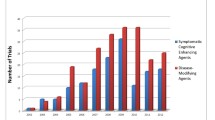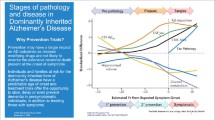Abstract
This paper reviews the scientific and ethical issues surrounding the conduct of bridging studies in patients with Alzheimer's disease (AD). Bridging studies, so called because they facilitate the transition from phase I to phase II development, are late phase I safety/tolerance studies which determine the maximum tolerated dose (MTD) in patients before initiating phase II efficacy studies. Determining the MTD in patients is important because we have found that AD patients appear to respond to cholinergic compounds differently from normal volunteers, reaching a different MTD. Preliminary evidence of dose-related efficacy with two cholinergic compounds lends support to our contention that determination of the highest tolerated dose maximizes the potential to detect efficacy.
We will review the early clinical development of several cholinergic compounds and make recommendations for the design and conduct of bridging studies based on our experience. A fixed-dose panel design with dosages based on the MTD determined in normal volunteers is recommended. In order to minimize risk to the patients, ensuring that scientific benefits outweigh the risks, a bridging study must be supported by detailed preclinical toxicology, by a clinical research unit that is prepared to handle unexpected contingencies, and by the oversight of a competent, multi-disciplinary review board. Patients should be in good physical health (excluding AD), and a comprehensive informed consent procedure must be instituted. Carefully planned and well run bridging studies represent a scientifically and ethically sound approach to drug development in the Alzheimer's population.
Similar content being viewed by others
References
Weissman L (1981) Multiple-dose phase I trials-normal volunteers or patients? One viewpoint. J Clin Pharmacol 21:385–387
Oates JA (1972) A scientific rationale for choosing patients rather than normal subjects for phase I studies. Clin Pharmacol Ther 13:808–811
Lipsett MB (1982) On the nature and ethics of phase I clinical trials of cancer chemotherapies. JAMA 248:941–942
Gelijns AC (1990) Modern methods of clinical investigation. National Academy Press, Washington, DC
Owen F, Cross AF, Crow TJ, et al (1978) Increased dopamine receptor sensitivity in schizophrenia. Lancet ii:223–226
Weinberger DR (1987) Implications of normal brain development for the pathogenesis of schizophrenia. Arch Gen Psychiatry 44:660–669
Joyce JN, Shane A, Lexow N, et al (1993) Serotonin uptake sites and serotonin receptors are altered in the limbic system of schizophrenics. Neuropsychopharmacol 8:315–336
Laruelle M, Abi-Dargham A, Casanova MF, et al (1993) Selective abnormalities of prefrontal serotonergic receptors in schizophrenia:a postmortem study. Arch Gen Psychiatry 50:810–818
Sramek JJ, Simpson GM (1994) Pharmacodynamics of antipsychotic drugs in schizophrenia. In: Cutler NR, Sramek JJ, Narang PK (eds) Pharmacodynamics and drug development: perspectives in clinical pharmacology. Wiley, Sussex, pp 181–199
Grof P, Akhter MI, Campbell M, et al (1993) Clinical evaluation of psychotropic drugs for psychiatric disorders. Hogrefe and Huber, Berne, Switzerland, p 152
Wu JC, Buchsbaum MS, Hershey TG, et al (1991) PET in generalized anxiety disorder. Biol Psychiatry 29:1181–99
Whitehouse PJ, Price DL, Struble RG, et al (1982) Alzheimer's disease and senile dementia: Loss of neurons in the basal forebrain. Science 215:1237–1239
Sims NR, Bowen DM, Allen SJ, et al (1983) Presynaptic cholinesterase dysfunction in patients with dementia. J Neurochem 40:503–509
Rossor M, Mountjoy CQ (1986) Post-mortem neuro-chemical changes in Alzheimer's disease compared with normal aging. Can J Neurol Sci 13:499–502
Geula C, Mesulam MM (1994) Cholinergic systems and related neuropathological predilection patterns in Alzheimer disease. In: Terry RD, Katzman R, Bick KL (eds) Alzheimer disease. Raven Press, New York, pp 263–291
Cutler NR, Sramek JJ, Seifert RD, Sawin SF (1993) The target population in phase I clinical trials of acetylcholinesterase inhibitors in dementia: the role of the “bridging study.” In: Corain B, Iqbal M, Nicolini M, Winblad B, Wisniewski H, Aztta P (eds) Alzheimer's disease: advances in clinical and basic research. Wiley, Sussex, pp 559–562
Cutler NR, Sramek JJ, Veroff AE (1994) Alzheimer's disease: optimizing drug development strategies. Wiley, Sussex
Puri SK, Hsu R, Ho I, Lassman HB (1989) Single dose safety, tolerance, and pharmacokinetics of HP 029 in young men: a potential Alzheimer's agent. J Clin Pharmacol 29:278–284
Puri SK, Hsu RS, Ho I, Lassman HB (1988) Single dose safety, tolerance and pharmacokinetics of HP 029 in healthy elderly men: a potential Alzheimer's agent. Curr Ther Res 44:766–780
Puri SK, Ho I, Lassman HB (1990) Multiple-dose pharmacokinetics, safety and tolerance of velnacrine (HP 029) in healthy elderly subjects: a potential therapeutic agent for Alzheimer's disease. J Clin Pharmacol 30:948–955
Cutler NR, Murphy MF, Nash RJ, Prior PL, DeLuna DM (1990) Clinical safety, tolerance, and plasma levels of the oral anticholinesterase 1,2,3,4-tetrahydro-9-aminoacridin-1-oL-maleate (HP 029) in Alzheimer's disease: preliminary findings. J Clin Pharmacol 30:556–561
Goldberg MR, Barchowsky A, McCrea J, et al (1991) Heptylphysostigmine (L-693,487): safety and cholinesterase inhibition in a placebo-controlled rising-dose healthy volunteer study. Presented at the Second International Springfield Symposium on Advances in Alzheimer Therapy, May 1991, Springfield
Sramek JJ, Block GA, Reines SA, Sawin SF, Barchowsky A, Cutler NR (1994) A multiple-dose safety trial of eptastigmine in Alzheimer's disease with pharmacodynamic observations of red blood cell cholinesterase. Life Sciences 56:319–326
Davis R, Raby C, Callahan MJ, et al (1993) Subtype selective muscarinic agonists: potential therapeutic agents for Alzheimer's disease. Prog Brain Res 98:439–445
Sramek JJ, Sedman AJ, Reece PA, et al (1995) Safety and tolerability of CI-979 in patients with Alzheimer's disease. Life Sci 57:503–510
Sramek JJ, Hurley DJ, Wardle TS, et al (1995) The safety and tolerance of xanomeline tartrate in patients with Alzheimer's disease. J Clin Pharmacol (in press)
Tollefson GD, Bodick NC, Shannon HC, Satterwhite JH, Sauerberg P (1994) Xanomeline: potent and specific M1 agonist in the treatment of Alzheimer's disease. Presented at the Annual Meeting of the American College of Neuropsychopharmacology, December 12–16, San Juan, Puerto Rico
Storer BE (1989) Design and analysis of phase I clinical trials. Biometrics 45:925–937
Spilker B (1991) Guide to clinical trials. Raven Press, Ltd., New York, pp 96–97
Geller NL (1984) Design of phase I and II clinical trials in cancer: a statistician's view. Cancer Invest 2:483–491
Levy G, Ebling WF, Forrest A (1994) Concentration-or effect-controlled clinical trials with sparse data. Clin Pharm Ther 56:1–8
Cutler NR (1988) Utility of biologic markers in the evaluation and diagnosis of Alzheimer disease. Brain Dysfunction 1:12–31
Sramek JJ, Cutler NR, Hurley DJ, Seifert RD (1995) The utility of salivary amylase as an evaluation of M3 muscarinic agonist activity in Alzheimer's disease. Prog Neuro- Psychopharmacol Biol Psychiat 19:85–91
Dayan AD (1991) The limitations of animal studies: what can and cannot be predicted for man. Drug Info J 25:165–170
Fleming TR, DeMeets DL (1993) Monitoring of clinical trials: issues and recommendations. Controlled Clin Trials 14:183–197
Summers W, Majoski L, Marik G, Tachiki K, Kling A (1986) Oral tetrahydroaminoacridine in long-term treatment of senile dementia, Alzheimer type. N Engl J Med 315:1241–1245
Davis KL, Thal LJ, Gamzu ER, et al (1992) A double-blind, placebo-controlled multicenter study of tacrine for Alzheimer's disease. New Engl J Med 327:1253–1259
Farlow M, Gracon SI, Hershey LA, et al. (1992) A controlled trial of tacrine in Alzheimer's disease. JAMA 268:2523–2529
Knapp MJ, Knopman DS, Solomon PR, et al. (1994) A 30-week randomized controlled trial of high-dose tacrine in patients with Alzheimer's disease. JAMA 271:985–991
Author information
Authors and Affiliations
Rights and permissions
About this article
Cite this article
Cutler, N.R., Sramek, J.J. Scientific and ethical concerns in clinical trials in Alzheimer's patients: the bridging study. Eur J Clin Pharmacol 48, 421–428 (1995). https://doi.org/10.1007/BF00194329
Received:
Accepted:
Issue Date:
DOI: https://doi.org/10.1007/BF00194329




